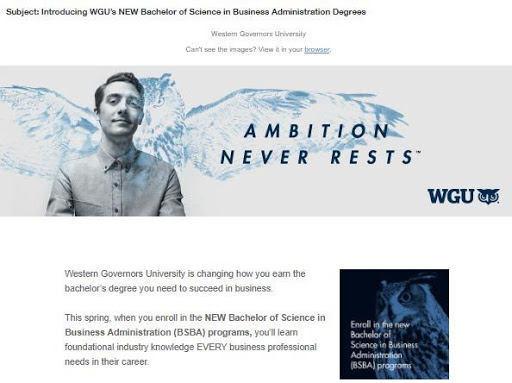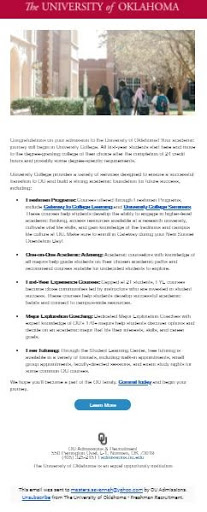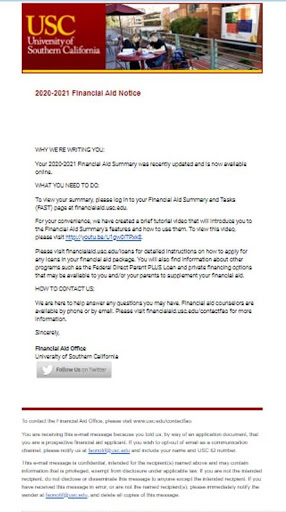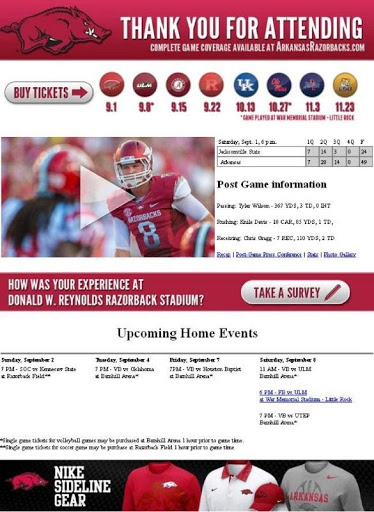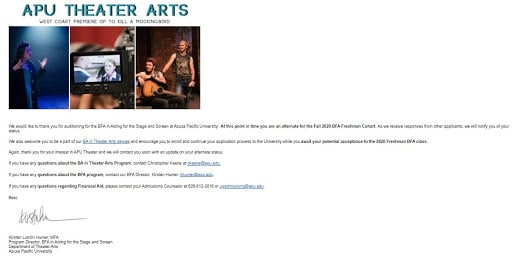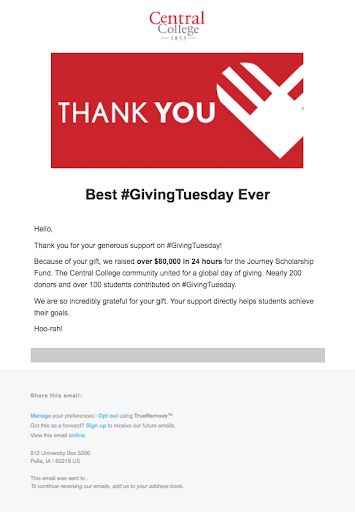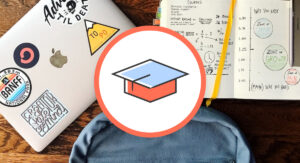How to create better transactional emails in higher ed
As a result of the coronavirus pandemic, the top 25 universities and colleges in the U.S. are shifting to remote learning this fall. In fact, more than 50% of universities will offer a distance-learning option.
Because the coming school year will have less face-to-face interactions, email communication is more important than ever.
Whether you’re following up on application status or confirming a payment, transactional emails are an integral part of maintaining a relationship with students. In this article, we’ll explore tips for creating effective, successful transactional emails for higher education.
What are transactional emails?
Transactional emails are automated messages sent to individual users in response to a request. Also called triggered emails, they help navigate processes by providing anticipated updates to an interaction. Transactional emails can be receipts or confirmations for a purchase or registration. They might provide information of an urgent nature like password reset details or verification code. Alternatively, they could simply be alerts triggered by a change in the recipient’s account information.
Recently, a study revealed that 68% of teens prefer to receive business communication by email. Transactional emails keep your audience updated on what’s happening with their involvement in your school. These emails can provide information about important forms, class changes, donation confirmations, and more.
Just because these messages are automated, they don’t have to suck. There are several opportunities to extend your brand further, engage your audience, build trust, and increase involvement. Avoid sending boring messages and take advantage of this opportunity to reach your students dynamically.
Here are 8 best practices for transactional emails that don’t suck
While it can be easy to create uninspired, plain text, automated messages, transactional emails can be engaging.
Several higher ed institutions are excelling with effective automated email marketing campaigns. Your school can succeed as well by following these best practices to create transactional emails that don’t suck.
1. Personalize your subject line
The average person receives more than 121 emails a day.
One way to help your messages stand out from the crowd is through personalized subject lines. They’re the first impression people have about your message. Readers determine whether to open your email based on the relevance of the subject line. By tailoring this information with the recipient’s name or something specific about the information they requested, you’re more likely to increase open rates.
Western Governors University sent this automated message to a prospective student who was interested in obtaining a business degree. Not only did the subject line mention the specific degree she was seeking, but it also alluded to new opportunities she might want to pursue. This is a great example of a highly personalized subject line that enticed the recipient to read the information inside.
Source: Western Governors University
2. Use consistent branding
Email access is no longer limited to your office desk. Mobile platforms have become the easiest solutions for consumers and businesses alike, with 35% of business professionals retrieving emails on a mobile device. That’s why your email campaign must be mobile friendly.
Transactional emails sent from the University of Oklahoma maintain branding throughout. The header is created in the school’s signature maroon, with their text logo across the top of the message. There’s no question about who this email is from.
Below that, they use a large image featuring a scene from their campus, which further helps identify the school. Finally, at the bottom of their message, they include their school logo. As the reader scrolls through the email, they always see some identifier of the school’s brand.
Source: University of Oklahoma
3. Create easy-to-read content
When a user requests a follow-up from a university, there can be a lot of information to provide.
It’s important to create concise content that gets to the point and is easy to read. Breaking content up into smaller paragraphs or bulleted lists can help make the information easier to digest. The reader will be more likely to absorb the essential details and take any necessary action.
The University of Southern California’s financial aid department does a great job of presenting important information in a way that’s simple to follow. Content is broken up into brief paragraphs that are easy to read. The main idea is in all caps so that the reader can identify pertinent information at a glance. The email includes clear calls to action, so the reader knows exactly what’s expected of them and how to proceed.
Source: University of Southern California
4. Relate to your audience
A great benefit of transactional emails is that users have provided information about themselves. This means your audience is easily identifiable. Use the details to create messaging that is targeted, meaningful, and resonates with the reader.
When prospective Arizona State University (ASU) students asked for more information, they automatically received this email from the admissions department. ASU’s message excels at identifying with their email recipients. A light-hearted tone speaks to their teenage audience and makes the university seem relatable. The message puts the recipient’s needs first, reminding students to have fun, enjoy the summer, and take time for self-care.
We know their goal is to increase interest and drive applications. However, they present their services as beneficial events that will help the reader learn, grow, and succeed. In this way, ASU is earning trust, building a foundation for a future relationship, and increasing the likelihood of bringing in more tuition.
Source: Really Good Emails
5. Ask for feedback
An effective way to connect with your audience is to show you value them by asking for their opinion. When you empower them to help in decision making, you show their involvement matters. You also make them feel that their experience is important to your school.
Use transactional emails to seek user feedback to help make improvements in events, processes, and user experiences.
After a sporting event, the University of Arkansas athletics department distributed a transactional email to thank attendees for their support. The email also recapped the game – complete with scores – and invited people to complete a survey about their event experience. Links to other purchase opportunities increase the likelihood of audience engagement and create a dynamic communication experience.
Source: University of Arkansas
6. Provide an element of customer service
Another element of a good transactional email is content that focuses on customer service.
Navigating higher ed administrative processes can be a confusing experience. Messages that provide useful updates and offer a funnel for student questions help alleviate frustrations.
Consider including direct links to department heads or student body leaders that could be helpful resources for students. A customer service-focused message helps to build brand loyalty and attract more students to enroll.
Azusa Pacific University’s (APU) Theater Arts department automatically sent this email out to performers who tried out for their program. It was meant to keep them updated about the status of their audition. APU took it a step further and provided a list of contacts students could reach out to for more information. Direct links to email addresses make the customer service element an easy step for readers. This gives the process transparency, which builds trust and makes answers seem accessible.
Source: Azusa Pacific University
7. Optimize for mobile
Emails are no longer accessed strictly from computers. Mobile platforms are a common way for people to keep in touch while out and about. In fact, 35% of people access email from a mobile device. Additionally, 46% of last year’s emails were opened on a mobile device.
Ensure that any images included in your email are scalable, so they come through without distortion. Confirm all text is formatted to fit a variety of screen sizes. You don’t want recipients missing out on important information because characters were cut off on their mobile devices.
This follow-up email from Central College has been optimized for mobile devices. Regardless of where recipients are accessing this message, they’ll know their contributions were received. They’ll also be kept in the loop with financial updates on their university-wide fundraiser.
Source: Central College
8. Include social media links
Social media is a great way to boost engagement and student interaction. It also helps build your brand. The content there is highly shareable, so it’s an effective platform for spreading the word about your university.
In your transactional emails, be sure to include links to your institution’s social media pages. This provides more ways for your audience to connect with your school and increase awareness about your programs.
The Antioch College alumni association includes links to their major social media platforms at the bottom of their transactional emails. This serves multiple purposes: Not only does this help alumni remain connected to the school, but it also encourages people to share photos and videos of their experience in this particular virtual alumni event. This builds community, increases alumni loyalty, and helps spread the word about the school.
Source: Antioch College
Wrap up
Higher education transactional emails are an important aspect of communicating with your student body. They’re especially effective when created with the following elements in mind:
-
Personalize your subject line
-
Use consistent branding
-
Create easy-to-read content
-
Relate to your audience
-
Ask for feedback
-
Provide an element of customer service
-
Optimize for mobile
-
Include social media links
By following these best practices, transactional emails can be a way to increase engagement, strengthen brand loyalty, and increase revenue.
We specialize in effective automated email marketing – and we can help your higher ed institution. Contact us today.
MOST RECENT ARTICLES
Want to engage your audience and grow your brand? Try Emma's robust easy-to-use product today.

